
HMS Ocean was a Landing Platform Helicopter, formerly the UK's helicopter carrier and the fleet flagship of the Royal Navy. She was designed to support amphibious landing operations and to support the staff of Commander UK Amphibious Force and Commander UK Landing Force. She was constructed in the mid-1990s by Kvaerner Govan on the River Clyde and fitted out by VSEL at Barrow-in-Furness prior to trials and subsequent acceptance in service. Ocean was commissioned in September 1998 at her home port HMNB Devonport, Plymouth.
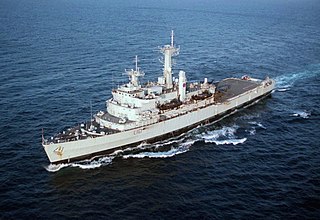
HMS Fearless (L10) was a Royal Navy amphibious assault ship that served from 1965 until 2002. One of two Fearless-class landing platform docks, she was based in HMNB Portsmouth and saw service around the world over her 37-year life. She was the last steam-powered surface ship in the Royal Navy.

HMS Intrepid (L11) was one of two Fearless-class amphibious warfare ships of the Royal Navy. A landing platform dock (LPD), she served from 1967 until 1999. Based in HM Naval Base, Devonport, Plymouth, Devon and HM Naval Base Portsmouth, she saw service around the world over her 32-year life.

Standing Royal Navy deployments is a list of operations and commitments undertaken by the United Kingdom's Royal Navy on a worldwide basis. The following list details these commitments and deployments sorted by region and in alphabetical order. Routine deployments made by the Navy's nuclear-powered submarines and their location of operations is classified.

The Commander-in-Chief Fleet (CINCFLEET) was the admiral responsible for the operations of the ships, submarines and aircraft of the British Royal Navy from 1971 until April 2012. The post was subordinate to the First Sea Lord, the professional head of the Naval Service. In its last years, as the Navy shrank, more administrative responsibilities were added.

Commander United Kingdom Strike Force is a senior post in the Royal Navy.

Surface ships form one of the five fighting arms of the Royal Navy.
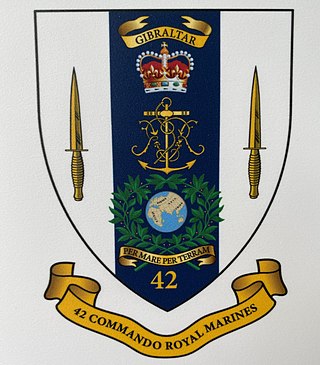
42 Commando is a subordinate unit within the Royal Marines 3 Commando Brigade. Based at Bickleigh Barracks near Plymouth, personnel regularly deploy outside the United Kingdom on operations or training. All Royal Marines personnel will have completed the Commando course at the Commando Training Centre (CTCRM) at Lympstone in Devon, entitling them to wear the green beret, with most attached personnel having completed the All Arms Commando Course.
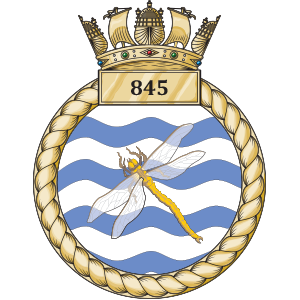
845 Naval Air Squadron is a squadron of the Royal Navy's Fleet Air Arm. Part of the Commando Helicopter Force, it is a specialist amphibious unit operating the AgustaWestland Commando Merlin HC4 helicopter and provides troop transport and load lifting support to 3 Commando Brigade Royal Marines. In 2012, the squadron celebrated 50 years since it was awarded "commando" status.
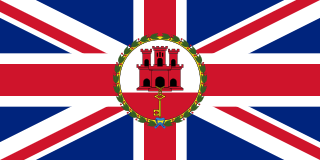
Admiral Sir Derek Roy Reffell, is a former Royal Navy officer and Governor of Gibraltar.

Navy Command is the current headquarters body of the Royal Navy, and as of 2012 its major organisational grouping. It is a hybrid, neither a command, nor simply an installation. Royal Navy official writings describe Navy Command Headquarters both as a physical site, on Whale Island, Hampshire, a collective formed of the most senior RN officers, and as a budgetary grouping.

The Joint Expeditionary Force (Maritime) (or JEF(M)) (formerly the Response Force Task Group (RFTG), and prior to that the Joint Rapid Reaction Force (JRRF)), is the Royal Navy's contribution to the UK Joint Expeditionary Force (JEF) maintained at very high-readiness and available at short notice to respond to unexpected global events. In addition to the Royal Navy and the Royal Marines, the JEF(M) also includes elements of the British Army and the Royal Air Force. While it is primarily poised to conduct war-fighting or strike operations, the JEF(M) is capable of undertaking a diverse range of activities such as evacuation operations, disaster relief or humanitarian aid.

Flag Officer, Carriers and Amphibious Ships (FOCAS) was a senior Royal Navy post that existed from 1970 to 1979. However, its antecedents date to 1931.

The Flag Officer, Third Flotilla was the senior Royal Navy appointment in command of the Third Flotilla from 1979 to 1992.
The Flag Officer, Surface Flotilla was a senior British Royal Navy appointment from 1990 to 2002.

The Commander United Kingdom Task Group (COMUKTG ) was a senior Royal Navy operational appointment from April 1992 to March 2015. In March 2015 the post was renamed Commander Amphibious Task Group.

The Commander United Kingdom Carrier Strike Group, (COMUKCSG) is a senior British Royal Navy appointment which commands the UK Carrier Strike Group. COMUKCSG, a Commodore, commands a total of 65 personnel, and is headquartered at HMNB Portsmouth.
Commodore Michael Cecil Clapp, is a retired senior Royal Navy officer who commanded the United Kingdom's amphibious assault group, Task Group 317.0, in the Falklands War.
A Littoral Response Group (LRG) is a Royal Navy task group consisting of at least two amphibious warfare ships, a company of Royal Marines and supporting elements primarily tasked with amphibious warfare from the littoral areas. They were first deployed in 2020 and have been described by the Royal Navy as being more flexible and agile compared to previous amphibious task groups with an emphasis on forward-basing, precision strike capabilities, high mobility, modern command and control technology, networked autonomous systems and deception capabilities. Multiple LRGs can combine to form a more substantial Littoral Strike Group (LSG) and they can also join a UK Carrier Strike Group to form an Expeditionary Strike Force.
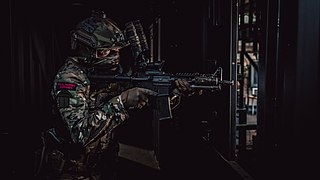
The Future Commando Force (FCF) is an in-progress modernisation programme and model of the future role and operations of the Royal Marines. The FCF essentially retasks 40 Commando and 45 Commando with implementing the infantry component of two Littoral Response Groups (LRGs), though other units from 3 Commando Brigade are also included in the composition of LRGs, as well as changing the role and operations of the Royal Marines and the equipment and tactics they use. The FCF concept was created before 2019, when the first exercises and experiments with the FCF began. It was reinforced in the Defence in a Competitive Age command paper, which followed the Integrated Review. It describes the Royal Marines as a forward-deployed maritime special operations/special operations capable force which will work with greater agility and autonomy, and in smaller teams that specialise in raids within littoral zones, and operations within grey zones and other special operations to relieve and complement United Kingdom Special Forces (UKSF). The emphasis on the littoral role of the Royal Marines strongly links the FCF to the Littoral Strike concept, which is being developed and implemented by the LRGs. The FCF is also strongly linked to the "Autonomous Advanced Force" concept by its emphasis on leveraging new technologies to augment commandos on operations. A series of exercises from 2019–present have been key to developing the FCF, chiefly with experimentation.











